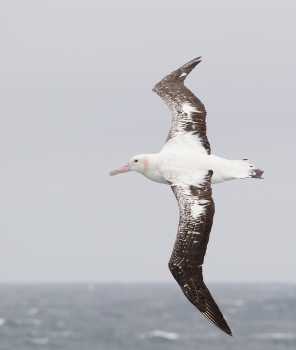Audrey Jaeger (Centre d'Etudes Biologiques de Chizé, France) and colleagues, publishing in the journal Ecology, look at changes in the foraging zones utilized by Wandering Albatrosses Diomedea exulans as they age.
The paper’s abstract follows:
“Evidence of age-dependent changes in foraging behavior of free-ranging individuals is scarce, especially at older stages. Using the isotopic niche as a proxy of the trophic niche during both the breeding (blood) and inter-nesting (feather) periods, we report here empirical evidence for age-, gender- and breeding status-dependent foraging ecology and examine its potential consequences on subsequent reproduction and survival in an extremely long-lived species, the wandering albatross. Immature wandering albatrosses of both sexes forage in the subtropics (δ13C) and feed at the same trophic position (δ15N) than the adults. In contrast to immature birds, adult females forage on average at northern latitudes than males, with both sexes feeding in the subtropics during the inter-nesting period, and males, not females, favouring subantartic [sic] waters during incubation. In contrast to adult females, males showed a unique pattern among birds and mammals of a continuous change with age in their main feeding habitat by foraging progressively further south in colder waters during both the breeding and inter-nesting periods. In males, foraging at higher latitudes (lower feather δ13C values) is associated with a lower probability to breed during the following years compared to other birds, but with no effect on their probability to survive. Foraging in cold and windy waters may be linked to foraging impairment that might explain different life history trade-offs and lower investment in reproduction with age. This key point requires further longitudinal investigations and/or studies examining foraging success and energy budget of birds feeding in different water masses.”

A Wandering Albatross forages in Antarctic waters, photograph by John Chardine
Click here to access a related publication by the CEBC team.
Reference:
Jaeger, A., Goutte, A., Lecomte, V.J., Richard, P., Chastel, O., Barbraud, C., Weimerskirch, H. & Cherel, Y. In Press. Age, sex and breeding status shape a complex foraging pattern in an extremely long-lived seabird. Ecology doi.org/10.1890/13-1376.1.
John Cooper, ACAP Information Officer, 13 February 2014

 English
English  Français
Français  Español
Español